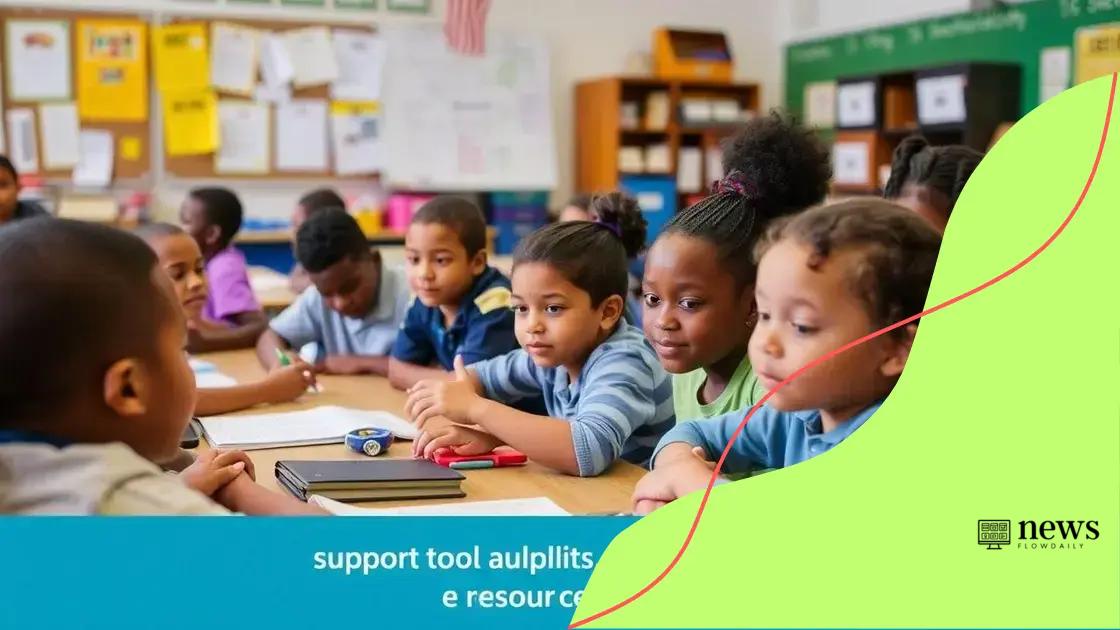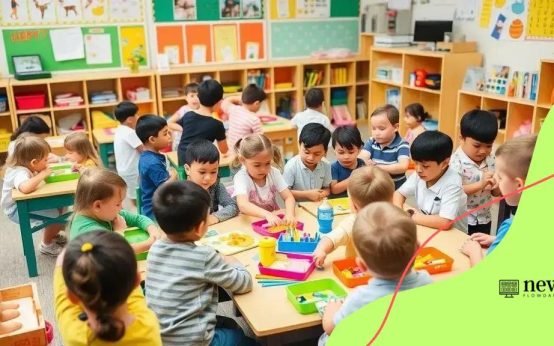Neurodiversity in the classroom emphasizes the importance of recognizing and valuing different learning styles, fostering an inclusive environment that supports all students through collaboration with parents and professionals.
Neurodiversity in the classroom is reshaping the way we approach education by recognizing and valuing different learning styles. How can we ensure every student feels included? Let’s explore!
Understanding neurodiversity and its importance
Understanding neurodiversity and its importance is crucial for creating an inclusive educational environment. It highlights how different brain types function and learn in unique ways. In a truly inclusive classroom, every student’s needs are recognized and met.
What is neurodiversity?
Neurodiversity refers to the variety of neurological conditions, such as autism, ADHD, and dyslexia. These conditions aren’t necessarily disabilities but represent different ways the brain can function. Understanding this concept helps educators appreciate how diverse learning can be.
The significance of embracing neurodiversity
Embracing neurodiversity is vital for fostering a supportive learning atmosphere. It allows all students to thrive, ensuring that everyone feels valued. Here are some key points that illustrate its importance:
- Promotes a positive self-image for neurodiverse students.
- Encourages creative thinking and problem-solving among all students.
- Enhances collaboration and understanding between peers.
- Supports emotional well-being by reducing stigma.
When we understand and accept neurodiversity, we create a rich tapestry of learning experiences. Different perspectives lead to innovative ideas, benefiting the entire classroom. Educators play a crucial role in establishing strategies that recognize and value these differences. By doing so, they nurture not only individual strengths but also a cohesive classroom community.
Different learning styles and their impact
Different learning styles can greatly influence how students absorb and understand information. Recognizing these styles allows educators to tailor their teaching methods effectively, making lessons more engaging and beneficial for all students.
Types of learning styles
Students often have unique preferences when it comes to learning. Some may thrive in hands-on environments, while others excel through auditory or visual means. Understanding these differences helps create a dynamic classroom.
- Visual learners prefer diagrams, charts, and images for comprehension.
- Auditory learners excel when they listen to information and participate in discussions.
- Kinesthetic learners learn best through physical activities and hands-on experiences.
- Reading/writing learners benefit from written material and engaging in extensive note-taking.
When teachers adapt their methods, they can cater to various learning styles, resulting in more effective education. Active participation is essential; students who connect with the material through their preferred style are likely to retain information better.
Impact of understanding learning styles
Understanding learning styles leads to a more inclusive and productive classroom. When students feel understood, they are more motivated to participate. This acceptance creates a culture of respect and support among peers, enhancing the learning environment.
Furthermore, implementing diverse teaching techniques helps foster critical thinking skills. Students learn to adapt and appreciate different approaches, which is vital for lifelong learning. By embracing the various learning styles, educators can not only help students succeed academically but also empower them to utilize their strengths beyond the classroom.
Strategies for inclusive teaching

Strategies for inclusive teaching are essential for creating a classroom where every learner feels valued. Effective educators recognize the diversity of their students and adapt their techniques to meet various needs.
Flexible teaching methods
Using flexible teaching methods helps accommodate different learning styles. For instance, integrating visual aids can assist students who are visual learners, while offering group discussions can benefit those who learn better through interaction. This approach fosters an environment where all students can engage with the material.
- Include multimedia resources like videos and infographics to cater to visual learners.
- Utilize storytelling and verbal explanations for auditory learners.
- Incorporate hands-on activities to support kinesthetic learners.
- Provide written materials and reading options for those who prefer reading/writing.
Building a supportive classroom culture is vital for inclusive teaching. It’s important to encourage collaboration among students. Pairing or grouping students with different strengths allows for peer learning, promoting a sense of community.
Creating a safe environment
Establishing a safe and inviting space is another key strategy. Students must feel comfortable expressing themselves and making mistakes. This can be accomplished by setting clear expectations and norms within the classroom. Regular check-ins with students help identify who may need additional support.
Incorporating feedback into your teaching practice is also beneficial. Asking students for input on the class structure enables educators to adjust lessons based on student needs. This adaptability shows students that their voices matter, reinforcing their confidence and participation in the learning process.
Creating a supportive classroom environment
Creating a supportive classroom environment is essential for all students to thrive. When students feel safe and accepted, they are more likely to participate and engage with learning.
Establishing trust and respect
Trust is a crucial factor in any classroom. Fostering an environment where students feel respected allows them to express their thoughts and feelings openly. One way to build trust is through consistent behavior from teachers. When students see that their educators are reliable, they feel more secure.
- Set clear expectations for behavior and communication.
- Model respect by listening to students and valuing their opinions.
- Encourage student collaboration to strengthen peer relationships.
- Provide positive feedback to boost confidence and morale.
Additionally, integrating social-emotional learning (SEL) into the curriculum can enhance the supportive classroom environment. SEL helps students understand and manage their emotions while building skills such as empathy and teamwork. This leads to a more cohesive class dynamic.
Creating inclusive spaces
The physical layout of the classroom impacts how students feel. An organized, inviting space encourages participation. Ensure that materials and resources are accessible to all learners. Use visual elements like charts and posters that reflect diverse cultures and experiences. This inclusivity shows that every student is valued.
Finally, regular communication with parents and guardians fosters a stronger community. Keep them informed about their child’s progress and encourage their involvement. This partnership enhances the sense of belonging for students, reinforcing a supportive classroom environment where everyone can succeed.
Collaboration with parents and professionals
Collaboration with parents and professionals is vital for the success of students in an inclusive classroom. Strong partnerships can lead to better outcomes for students, especially those who are neurodiverse.
The role of parents
Parents play a key role in their child’s education. They understand their child’s strengths and challenges better than anyone else. By communicating regularly, educators can gain valuable insights that help tailor teaching methods. Meetings and open-house events allow parents to share their concerns and suggestions.
- Invite parents to participate in workshops and school activities.
- Encourage them to share resources and strategies that work at home.
- Provide regular updates on their child’s progress.
- Foster an open-door policy for questions and discussions.
When parents feel engaged, their children often mirror that interest in learning. This connection strengthens the student’s confidence and motivation in the classroom.
Working with professionals
Collaboration with professionals, such as counselors, special education teachers, and psychologists, is also essential. These experts can offer additional support and strategies tailored to individual needs. Regular meetings with these professionals help to create a holistic approach to education.
Integrating their insights can lead to effective strategies within the classroom. This collaboration allows teachers to implement practices that accommodate different learning styles. Resources from professionals can enhance the educational experience, making it more inclusive for all students.
Ultimately, by fostering a strong network with both parents and professionals, educators create a more enriching learning environment. This leads to better understanding and support systems that are crucial for student success.
FAQ – Frequently Asked Questions about Neurodiversity in the Classroom
How can I support my neurodiverse child at school?
Engage with teachers and share your child’s strengths and challenges. Communication is key to ensuring their educational needs are met.
What are the benefits of inclusive teaching?
Inclusive teaching fosters a sense of belonging, improves student engagement, and allows all learners to benefit from diverse perspectives.
How do I communicate effectively with educators?
Stay in regular contact and provide feedback. Attend school meetings and express any concerns about your child’s progress.
What role do professionals play in supporting neurodiverse students?
Professionals like therapists and special educators provide expertise and resources, helping to create tailored learning strategies that benefit individual students.


 EarlyEducationPush: Unlocking the Potential of Young Minds
EarlyEducationPush: Unlocking the Potential of Young Minds  CollegeAccessPlans: Unlocking educational opportunities for all
CollegeAccessPlans: Unlocking educational opportunities for all  FAFSA Changes 2025: What You Need to Know
FAFSA Changes 2025: What You Need to Know